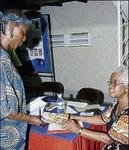
Winston Sill/Freelance Photographer
Carolyn Allen (left) and Erna Brodber were integral to the staging of 'Break the Waters ... Set The Echoes Free' in their capacities with the Philip Sherlock Centre for the Creative Arts and Blackspace, respectively.
Mel Cooke, Freelance Writer
Somewhere during Break The Waters of the Deep ... Set The Echoes Free, last Sunday, the skies opened to release a torrent to greet those leaving the Philip Sherlock Centre for the Creative Arts, UWI, Mona, in the early afternoon.
Before there was water from above outside, though, there had been figurative water on the stage inside as the dramatised sequence of readings covered the Transatlantic Slave Trade in extreme detail, causing one woman to exclaim in a near wail in the open floor segment after that "I feel it, I feel it".
There had been a lot to feel, from the audience's opening trek through the bowels of the centre to simulate the slave ship experience through to the ending examination of reparation ("Show me the money," one young man said to chuckles, in one of the production's very few light moments), then the closing climax of a near-frenetic chant of the title, a refrain which had come up periodically throughout.
Striking images
The central figures in Break The Waters of the Deep ... Set The Echoes Free took front and centrestage throughout most of the production, with narrators and drummers seated on boxes at the rear of the stage. A series of black and white images was projected on to a large screen behind them all, one of the most striking being rows and layers of the soles of bare feet coming as a description of how the Africans were transported was being read.
An the Europeans were given due credit for their mastery of slavery ("Oh my God, what a way for a Christian subject of His Majesty to live. Those blasted drums, night and day," one slave ship captain said), the role of Africans in the trade was not shied away from.
Those 'blasted drums' hit a crescendo after one man said, "I was first betrayed and kidnapped by my own countrymen," and there was a dramatic depiction of a raid, with Africans rushing from the wings to point weapons at the captive.
European backing
The point was made, though, that "if there had been no buyers, there would be no sellers", as well as the fact that the slave trade had the backing of prominent European investors.
Capture by force was not the only way that Africans were taken away and extensive treatment was given to a ship that visited the coast thrice, the first time with the captain making friends with the Africans and leaving gifts, a large red cross among them, and the third time inviting the Africans on board for a party at which they were given alcohol and taken away.
And the name of one particular ship, the 'Jesus' was written down in memory.
With a blue strip of cloth hanging over the captain's arm transformed into the waters that carried the moaning Africans away for a turbulent voyage, the captured in a groaning huddle wrapped up by the blue, the connection was made between those who were kidnapped and those who remained in Africa.
Numbers were put to the horror, with an auction style reading of the figures of those taken away between 1519 and 1867 coming up to over 10 million.
There was no way to enumerate the suffering on-board, though, as one actress wailed "me nah talk whe dem do me pon de ship".
What was spoken about, though, was the events on the slave ship the Zong in 1781, when captured Africans were thrown overboard in the interest of cutting costs while ensuring a profit ("To stop sickness and save water", the captain said) and there was a horrible screaming as the Africans were tumbled off-stage.
In all, 122 were drowned.
Reparations
When they came back on the stage, the clanking of chains that had been a part of Break The Waters of the Deep ... Set The Echoes Free was gone and it was a hop and skip to more recent times and the somewhat scornful query, "What your parents tell yu? Sey mi come from Africa?" The observation that "to die for freedom is the ultimate morality" came before the closing discussion of reparation ("Reparation is mainly about making repairs, self-made repairs on ourselves").
Members of the Jamaica Youth Theatre and the UWI Dramatic Arts Society appeared along with Amina Blackwood-Meeks, Hugh Douse, Sabrena McDonald, Randy McLaren, Nadean Rawlins, Karl Williams and Quinton Yearde, with Calvin Mitchell, Dexter Baccus and Dike Rostant providing the music. Eugene Williams directed Break The Waters of the Deep ... Set The Echoes Free, with movement by L'Antoinette Stines, with Carolyn Allen of the Philip Sherlock Centre, who was a narrator and moderated the question-and-answer session, having multiple functions.
Break The Waters of the Deep... Set The Echoes Free, presented by the Philip Sherlock Centre, is collaboration with Erna Brodber's Blackspace and the Jamaica National Bicentenary Committee.

